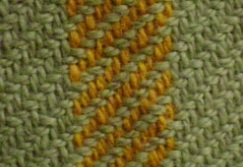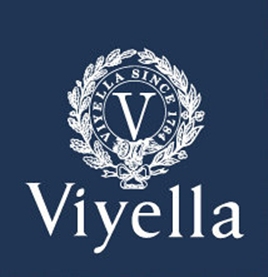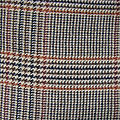
Worsted is a high-quality type of wool yarn, the fabric made from this yarn, and a yarn weight category. The name derives from Worstead, a village in the English county of Norfolk. That village, together with North Walsham and Aylsham, formed a manufacturing centre for yarn and cloth in the 12th century, when pasture enclosure and liming rendered the East Anglian soil too rich for the older agrarian sheep breeds. In the same period, many weavers from the County of Flanders moved to Norfolk. "Worsted" yarns/fabrics are distinct from woollens : the former is considered stronger, finer, smoother, and harder than the latter.

Serge is a type of twill fabric that has diagonal lines or ridges on both inner and outer surfaces via a two-up, two-down weave. The worsted variety is used in making military uniforms, suits, greatcoats, and trench coats. Its counterpart, silk serge, is used for linings. French serge is a softer, finer variety. The word is also used for a high-quality woven woolen fabric.

Gabardine is a durable twill worsted wool, a tightly woven fabric originally waterproof and used to make suits, overcoats, trousers, uniforms, windbreakers, outerwear and other garments.

Twill is a type of textile weave with a pattern of diagonal parallel ribs. It is one of three fundamental types of weave, along with plain weave and satin. It is made by passing the weft thread over one or more warp threads then under two or more warp threads and so on, with a "step," or offset, between rows to create the characteristic diagonal pattern. Because of this structure, twill generally drapes well.

Flannel is a soft woven fabric, of varying fineness. Flannel was originally made from carded wool or worsted yarn, but is now often made from either wool, cotton, or synthetic fiber. Flannel is commonly used to make tartan clothing, blankets, bed sheets, sleepwear, and several other uses.

A shawl is a simple item of clothing, loosely worn over the shoulders, upper body and arms, and sometimes also over the head. It is usually a rectangular piece of cloth, but can also be square or triangular in shape. Other shapes include oblong shawls. It is associated with the inhabitants of the northern Indian subcontinent—particularly Kashmir and Punjab—and Central Asia, but can be found in many other parts of the world.

Harris tweed is a tweed cloth that is handwoven by islanders at their homes in the Outer Hebrides of Scotland, finished in the Outer Hebrides, and made from pure virgin wool dyed and spun in the Outer Hebrides. This definition, quality standards and protection of the Harris tweed name are enshrined in the Harris Tweed Act 1993.

The Wool Act 1698 was an Act of the Parliament of England, long titled An Act to prevent the Exportation of Wool out of the Kingdoms of Ireland and England into Forreigne parts and for the Incouragement of the Woollen Manufactures in the Kingdom of England. It was intended to increase England's woolen product manufacturing by preventing Irish wool production, manufactures, and export; it also forbade the export of wool and products from the American colonies. Competing woolens from these areas had recently become more available in foreign and domestic markets. The Act prohibited American colonists from exporting wool and wool products, or export to markets outside the individual colony in which it was produced, or to be transported from one place to another in the same colony. The act did not forbid the making of woolen fabrics for private consumption, but simply forbade the making of woolens for the public market. At this time the woolens exported from England had to pay heavy export duties. The act, one of the Acts of Trade and Navigation, was mainly aimed at Irish woolens and established a policy to crush the Irish woolen industry. It had little effect on the American colonies; at most it only slowed the potential industry. Shopkeepers had a very hard time during this period when the Wool Act was in force. Some colonists opposed this act by buying more flax and hemp.

Houndstooth, hounds tooth check or hound's tooth, also known as dogstooth, dogtooth, dog's tooth,, is a duotone textile pattern characterized by a tessellation of light and dark solid checks alternating with light-and-dark diagonally-striped checks—similar in pattern to gingham plaid but with diagonally-striped squares in place of gingham's blended-tone squares—traditionally in black and white, although other contrasting colour combinations may be used.

Viyella is a blend of wool and cotton first woven in 1893 in England, and the "first branded fabric in the world". It was made of 55% merino wool and 45% cotton in a twill weave, developed by James and Robert Sissons of William Hollins & Co, spinners and hosiers. The brand name, first registered as a trademark in 1894, and registered in the United States in 1907, soon covered not only the original fabric, to be sold by the yard, but also clothing. At first this was made by separate businesses, but it was not long before Hollins started producing their own clothes and offering franchises to manufacturers who would use the Viyella label. Following increasing emphasis on garment manufacture over the years, Viyella is now a fashion brand for clothes and home furnishings made of a variety of fabrics. The original wool/cotton blend is no longer sold.
The manufacture of textiles is one of the oldest of human technologies. To make textiles, the first requirement is a source of fiber from which a yarn can be made, primarily by spinning. The yarn is processed by knitting or weaving, which turns yarn into cloth. The machine used for weaving is the loom. For decoration, the process of colouring yarn or the finished material is dyeing. For more information of the various steps, see textile manufacturing.

Magee of Donegal are a textile manufacturer, clothing manufacturer and retailer, and manufacturer and retailer of home goods based in Donegal Town, County Donegal, Ireland. The company are known for their woolen Donegal tweed, but also manufacture items from linen, cashmere, silk and other materials.

Ivy League is a style of men's dress, popular during the late 1950s in the Northeastern United States, and said to have originated on college campuses, particularly those of the Ivy League. It was the predecessor to the preppy style of dress.

H. Huntsman & Sons is a high-end fashion house and tailor located at No. 11 Savile Row, London. It is known for its English bespoke menswear tailoring, cashmere ready-to-wear collections, and leather accessories.

Herringbone, also called broken twill weave, describes a distinctive V-shaped weaving pattern usually found in twill fabric. It is distinguished from a plain chevron by the break at reversal, which makes it resemble a broken zigzag. The pattern is called herringbone because it resembles the skeleton of a herring fish. Herringbone-patterned fabric is usually wool, and is one of the most popular cloths used for suits and outerwear. Tweed cloth is often woven with a herringbone pattern.

Donegal tweed is a woven tweed manufactured in County Donegal, Ireland. Originally all handwoven, it is now mostly machine woven and has been since the introduction of mechanised looms in the 1950s-1960s. Donegal has for centuries been producing tweed from local materials in the making of caps, suits and vests. Towards the end of the eighteenth century, The Royal Linen Manufacturers of Ulster distributed approximately six thousand flax spinning wheels and sixty looms for weaving to various Donegal homesteads. These machines helped establish the homespun tweed industry in nineteenth-century Donegal. Although Donegal tweed has been manufactured for centuries it took on its modern form in the 1880s, largely due to the pioneering work of English philanthropist Alice Rowland Hart.

Traditional Irish clothing is the traditional attire which would have been worn historically by Irish people in Ireland. During the 16th-century Tudor conquest of Ireland, the Dublin Castle administration proscribed many of Ireland’s clothing traditions. A series of photos captured by French photographers Marguerite Mespoulet and Madeleine Mignon-Alba in 1913 included images of Irish people in traditional clothing. Some of these photos were taken in Claddagh, a town thought to have retained much of its traditional attire.

The Harris Tweed Authority (HTA) is an independent statutory public body created by the Harris Tweed Act 1993, replacing the Harris Tweed Association, which was formed in 1910. The Harris Tweed Authority is charged with the general duty of furthering the Harris Tweed industry as a means of livelihood for those who live in the Outer Hebrides of Scotland.

Kerry Woollen Mills are historic wool mills based just off the Ring of Kerry.































